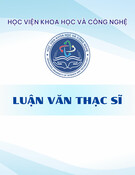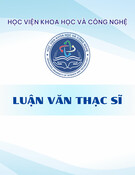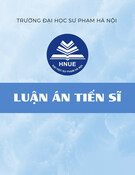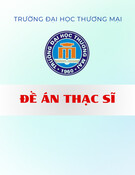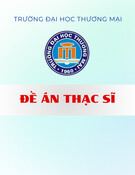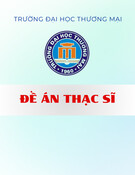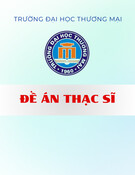
MINISTRY OF EDUCATION AND TRAINING
VINH UNIVERSITY
LE MINH GIANG
USA - CUBA RELATIONS
(1991 - 2016)
THESIS SUMMARY
NGHE AN - 2020

0
THE DISSERTATION WAS COMPLETED
AT VINH UNIVERSITY
Supervisors: 1. Assoc. Prof. NGUYEN CONG KHANH
2. Prof. HOANG KHAC NAM
Reviewer 1:
Reviewer 2:
Reviewer 3:
The dissertation will be protected before the doctoral dissertation evaluation board
at Vinh University
At............on..............................,.............
The dissertation can be found at:
- National Library of Vietnam;
- Nguyen Thuc Hao Information Centre & Library, Vinh University.

1
INTRODUCTION
1. Rationale
1.1. In the history of modern international relations, there is rarely a
complicated and tense bilateral relationship as the one between the US and Cuba.
Both countries are located in the America and geograpcially close to each other (150
km), but their relationship has been frozen for more than half a century (1961 - 2015).
After the Cold War, even after the collapse of the Soviet Union, the United
States continued to strengthen the embargo toward Cuba with the Cuban Democratic
Acts (1992) and the Helms-Burton Act (1996), in which the condition for the
abolition of embargo was that Cuba must hold free, fair and forward elections to a
democratic government. Turning to the twenty-first century, the reality proves that
the US policies of hostility, aggression, embargo and isolation against Cuba have
ceased to take effect, and in fact those policies of the US have caused many losses,
difficulties for Cuba for decades. Both subjective factors (US, Cuba) and objective
factors have led to policy changes between the two countries towards each other. This
has been evident since Barack Obama became President of the United States in early
2009 and the fact that Fidel Castro has officially handed over the position of
President of Cuba to the First Vice President and his younger brother Raúl Castro in
2008.On December 17, 2014, US President B. Obama and Cuban President R. Castro
announced the restoration of US-Cuba relations after more than 5 decades of
hostility. From that time, Cuba and the US officially began the process of
normalizing relations. On April 11, 2015, President B. Obama and President R.
Castro shook hands at the American Summit in Panama, marking the first meeting of
the leaders of the two countries since their isolations in 1961. The normalization of
diplomatic relations with Cuba on July 20, 2015 is part of B. Obama's main policy,
ending a decades-long approach to US-Cuba relation foreign policy. This is a historic
decision, opening a new step of development of US-Cuba relations. The
normalization of relations between the United States and Cuba has greatly affected
Latin American countries and the world, creating opportunities and prospects for
cooperation between the US and Cuba in the 21st century.
1.2. There have been many domestic and foreign scholars studying US and
Cuban relations. However, in Vietnam, this US- Cuban relationship on two important

2
aspects of economy and politics after the Cold War has not been given due attention.
US-Cuba relations after the Cold War still have many scientific issues that need to be
studied in a more comprehensive way. There is a need for the study related to the
influential factors, achievements, limitations, characteristics and multidimensional
impacts of this relationship.
1.3. It is crucial to study the bilateral relationship between the United States
and Cuba on all aspects, especially politics - diplomacy and economics from 1991 to
2016 because it brings about both scientific and practical significance.
In terms of scientific significance, studying US-Cuba relations since the Cold
War, improves the understanding of the factors, origin, process of making policies
and implementing US policies towards Cuba. At the same time, we can see the
picture of relations between the two countries in key areas and highlight the
characteristics of US-Cuba relations during 1991-2016.
From a practical perspective, the study of the US-Cuba bilateral relationship
contributes to the development of relations with both countries (USA, Cuba) and
provides useful references for researchers as well as educators and learners about
modern world history and international relations.
Stemming from the above reasons, studying "US - Cuba relations (1991 -
2016)" was chosen as our doctoral research.
2. Research aim and objectives
2.1. Aim: The thesis aims to clarify the movement and developmennt of US-
Cuba relations from 1991 to 2016 and explains why there is such a change.
2.2. Objectives
- Analyze the literature review relating to US-Cuba relations in the world and
in Vietnam, and then identify the advantages and limitations of the researched works.
The study then filled the gaps by providing the novelty in the research field.
- Clarify different factors affecting the US-Cuba relationship from the Cold War until
2016. Moreover, it focused on the analysis of the current state of US-Cuba relations
from 1991 to 2016 on 2 fields: politics - diplomacy and economics.
- Assess US-Cuba relations from 1991 to 2016 to highlight achievements and
shortcomings; characteristics and impacts of this relationship on each country, on the
region and on the world.

3
3. The subjects and scope of the study
3.1. Subjects: The research object of the thesis is US-Cuba relations in the
period from 1991 to 2016. The topic focused on studying US and Cuban relations
since the end of the Cold War (1991) until the end of presidential term of US
President B. Obama (2016).
3.2. Scope
The topic focused on studying US-Cuba relations (1991 - 2016) in terms of
two main aspects: politics - diplomacy and economics. Regarding political-
diplomatic field, it aimed at clarifying diplomatic meetings, agreements and
disagreements between the US and Cuba, especially the process of normalizing such
relations. With regards to the content of economic relations, the study focused on
successes and limitations in trade and investment relations between the US and Cuba.
The content of culture and society is only mentioned scattered in the thesis as a
catalyst for the normalization of relations.
The historical time that the thesis subjected to is from 1991 to 2016. The 1991
landmark was the end of the Cold War, marking a fundamental change in the world
situation and international relations. More specifically, there was a shift in the
strategic awareness of the US and Cuba. The 2016 milestone is the year that
essentially ends the second term of President B. Obama, leading to major changes in
US-Cuba relations.
The thesis studied US-Cuba relations (1991 - 2016) in two stages: the period of
1991 - 2008 and the period of 2009 - 2016. The reason for this divergence is that in
the 1991-2008 period, although the relationship The United States and Cuba continue
to be tense, there have been certain signs of change in the policies of the two
countries. In the 2009 – 2016 period, US policy towards Cuba has changed
dramatically since B. Obama became US President (early 2009) and Fidel Castro
officially transferred the position of Cuban leader for his younger brother Raúl Castro
(2008).
4. Theoretical framework and research methods
4.1. Theoretical framework: The research was carried out based on an thorough
understanding of dialectical materialism and historical materialism of Marxism -
Leninism, Ho Chi Minh thought and the Vietnamese Communist Party’s views on
International relations.

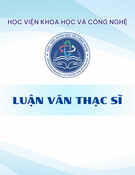
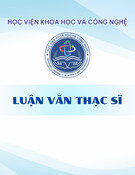
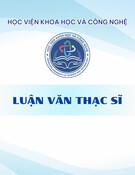
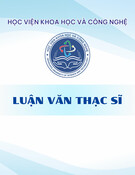
![Luận văn Thạc sĩ: Tổng hợp và đánh giá hoạt tính chống ung thư của hợp phần lai tetrahydro-beta-carboline và imidazo[1,5-a]pyridine](https://cdn.tailieu.vn/images/document/thumbnail/2025/20250816/vijiraiya/135x160/26811755333398.jpg)
